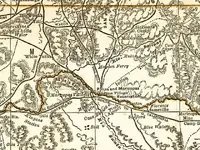It is also interesting that Larry Webb and Azmula, both of who had been in touch with the Tumlinson family and had actually corresponded with them, had (as I recall it) independently come to the belief that Travis got the Stone Maps from his grandfather, "Peg Leg" Tumlinson.
This is not to discount what happened at QC, because there are too many elements that fit together for something not to have happened there.There are a few other elements which make it very hard to rule QC out, and one of them is the discovery of the LH laying on the ground, some distance away, the very act of which points to a specific provenance.
Those two details may seem to contradict each other, but-
A scenario I am considering is that what "Peg Leg" Tumlinson had, and eventually gave to Travis was the H/P stone, along with further directions or perhaps a waybill or derroterro, and this is pretty much evidenced by the Galleon/TC stone that Travis carved. I do not think it an accident that this stone has two sides to it, the additional inscribed details with subtle hints (e.g. the year 1535) and furthermore the style of at least one letter is very similar to that which is on the Horse side.
I postulate that Travis was directed to the area at QC where he found the TS buried together, face to face, in order to keep the HS from getting lost. As Garry has pointed out, the story of Travis "accidentally" discovering the stones just doesn't stand up under close scrutiny, but this doesn't rule out Travis going there intentionally, or looking for something specific.
This is further corroborated by the fact that as various letters have pointed out, Travis spent the majority of his time with the TS, and evidently did not think much of the H/P stone. Such actions would corroborate the premise that the TS were what Travis discovered at QC.



 For what it's worth, here is my view.
For what it's worth, here is my view.
